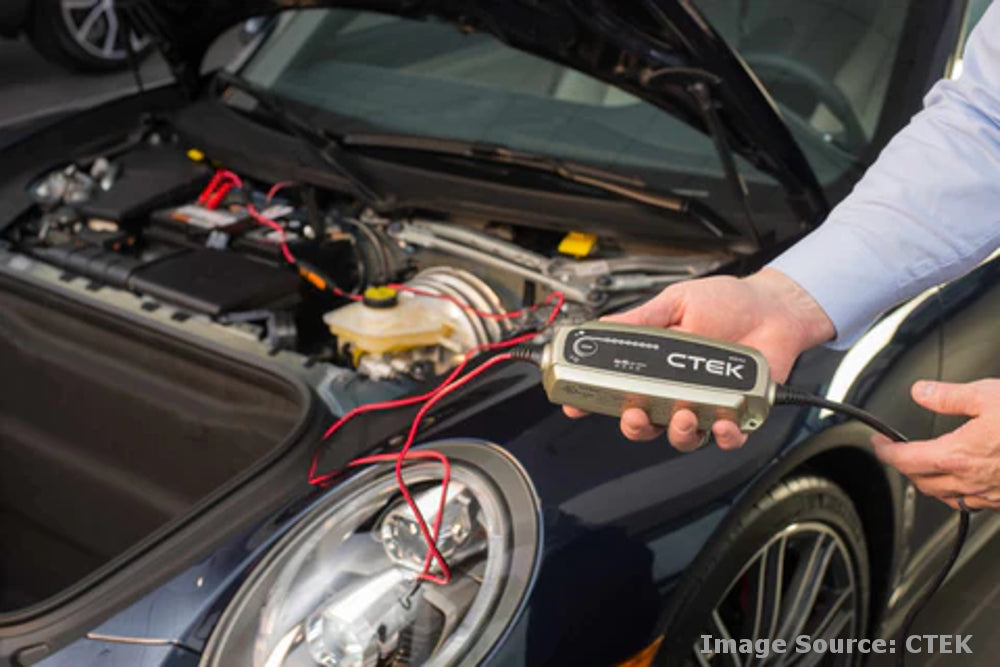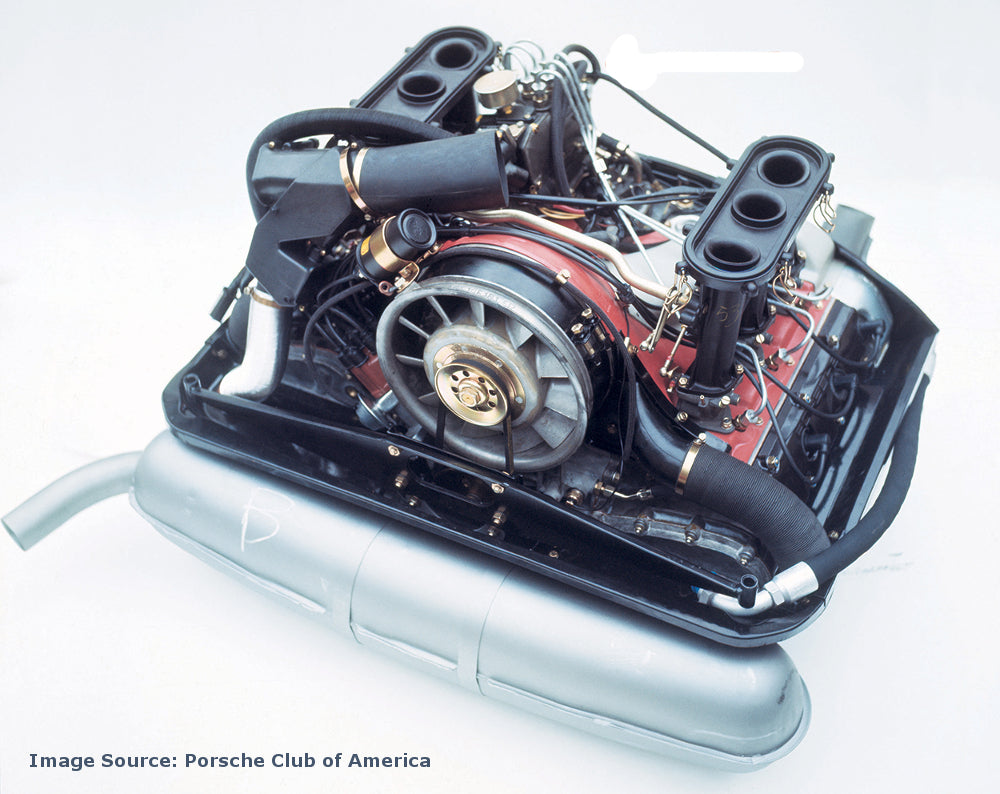While Electronic Fuel Injection (EFI) finally allowed Porsche to optimize fuel-metering and delivery, the other factor in the combustion equation, ignition, although also digitized, still operated independently from the fuel system. So with emissions regulations being tightened and customers looking for more performance Porsche integrated these two critical co-dependant systems into a single electronic engine management system.
This was a game changer for Porsche. Using the L-Jetronic system as the basis for the integrated fuel metering and electronic ignition timing control systems Bosch developed the Motronic range of ECUs - referred to as the DME (digital motor electronics) control unit by Porsche.
In this article, we will take a look at Porsche’s Motronic DME as well as the company’s adoption of direct fuel injection, sometimes also referred to as Gasoline Direct Injection (GDI).
Porsche Goes From Fuel Metering To Full Engine Management
Porsche first used the Motronic DME in the 1983 944, with the 928 and 3.2-liter 911 following closely behind. These initial applications of the system still featured simultaneous injection (all injectors inject at the same time) and, because the digital ignition dwell and timing controls ideally required the accurate measurement of engine speed and position, the system was equipped with a pair of inductive sensors. Thus the engine speed sensor generated an analog signal triggered by the starter ring gear teeth, with the reference mark sensor signaling top-dead center for cylinder #1.
The DME control unit relied on a central microprocessor to convert the various analog and digital input signals into the digital square wave signal required to control the fuel injectors. (The analogue signals are converted using the ADC – the Analogue to Digital Converter). The pulse-width (and ignition timing/dwell) settings were controlled by a three-dimensional map stored in an onboard EPROM (erasable programmable read-only memory) “flash” chip.

Even though a basic closed-loop feedback/oxygen sensor (Lambda Sensor) system was “piggybacked” onto later versions of the 911 CIS injection system, Porsche’s Motronic DME integrated a heated oxygen sensor directly into the system. This allowed for the optimization of the catalytic converter operation, along with a limited ability to correct excessively lean or rich air/fuel mixtures and adjust ignition timing (dwell).
The 16-valve 944S of 1987 featured an updated Motronic system, which added a Hall effect sensor and trigger wheel to the distributor drive, which allowed the DME control unit to determine which cylinder was firing at any given point. This camshaft position sensor allowed the DME to retard the ignition timing of individual cylinders in response to any detonation events (as detected by a pair of dedicated knock sensors fitted to the engine block), as well as enabling true sequential fuel injection. By timing each injection event to occur just before each intake valve opened, the full benefits of fuel atomization from the injector tip could be realized, which resulted in improved fuel consumption and emissions, and smoother idle and part-throttle drivability.
The 1987 928 S4 and 1989 964 similarly benefited from this updated Motronic system, which also could store fault codes for a limited number of irregular running conditions. To aid diagnosis these fault codes could be read using the Porsche System Tester (PST) scan tool.
The other challenge Porsche sought to overcome, was the accurate and reliable measurement of the airflow into the engine. While the mechanical airflow meters proved to be quite reliable, they were prone to wear of the electrical wiper tracks, and a severe blow-back through the intake could physically damage the unit by causing the movable vane to drag or get stuck.

More importantly, the airflow meter itself represented a restriction to airflow, which was becoming an issue as Porsche’s engine displacement increased. However, contrary to popular belief, this restriction was not caused by the vane itself (Bosch test data shows a pressure drop of only 0.017 psi across it), but because of the relatively small rectangular slot required to meter the airflow.
What is more, airflow into the engine, as measured by both speed-density and vane airflow systems, was traditionally an indirect estimate of the air mass. The ideal (stoichiometric) air/fuel ratio of a gasoline engine to burn all the fuel - which is about 14.7 parts of air to 1.0 part of fuel - is more effectively based on the mass of the elements involved.
Hence the 32-valve 928 saw Porsche’s first use of a hot-wire mass airflow (MAF) sensor to replace the vane airflow meter of earlier systems (the 1992 968 featured a MAF sensor, but the 911 did not get this update until the introduction of the 993 series in 1994). The MAF sensor used electrically heated wires mounted within a tube calibrated to match the engine’s airflow characteristics.

The DME control unit monitored the current required to maintain a constant wire temperature. An increase in the mass of air passing through the sensor cooled the wires, requiring the DME to increase the current to maintain the pre-set wire temperature. The MAF signal thus generated was used to accurately measure the true mass of the air flowing into the engine, which greatly improved the accuracy of the engine load signal and thus the accuracy of the amount of fuel injected.
For the 1996 model year, US-bound 993s featured government-mandated second-generation onboard diagnostic (OBD-II) capabilities. While previous (OBD-I) systems could only detect basic malfunctions such as a completely inoperative oxygen sensor or an open or short circuit in the wiring of a sensor, OBD-II monitored the health of the various onboard emission control systems.
An additional oxygen sensor downstream of each catalyst monitored catalytic converter health, and catalyst-damaging engine misfires could be detected by monitoring any sudden deceleration of the crankshaft (and the offending cylinder could be identified by monitoring the correlation between the camshaft and crankshaft position sensors). The secondary air injection system function was also monitored, along with that of the evaporative/fuel vapor recovery system (which is why a loose fuel filler cap can cause a “check engine” light in OBD-II cars).
The 986 Boxster and 996/997-generation 911s featured an evolution of the Bosch Motronic system with VarioCam variable camshaft timing controls (which actually debuted on the front-engined 1992 Porsche 968), which required a more elaborate Hall effect sensor design to accurately measurement the camshaft position.
Electronic throttle control (drive-by-wire) appeared on the 1999 996 Carrera 4 and all engines for 2000, which allowed the integration of the torque-reduction feature of Porsche Stability Management (PSM).
The 2002 3.6-liter 996 Carrera and all Boxsters from 2003 also saw the introduction of a ‘returnless’ fuel system. This system eliminated the fuel return line from the engine bay to the tank, with only the amount of fuel required by the engine fed to the fuel rails. This overcame the problem of heated fuel returning to the fuel tank increasing evaporative fuel emissions.
Whilst the Motronic DME did an excellent job of metering the fuel and delivering it and the spark at exactly the right time for optimized combustion, the combustion process could be further improved if the fuel was injected directly into the combustion chamber.
Direct Fuel Injection – The Final Chapter In Porsche’s Quest To Optimize Combustion
In a traditional fuel injection engine, fuel is injected into the intake manifold where it mixes with the air. This air-fuel mixture is then fed into the combustion chamber when the intake valves open.
Porsche has used this basic fuelling principle since the introduction of mechanical fuel injection on the 911 in the 1960s. However, starting with the Cayenne in 2007, Porsche revamped its entire engine lineup with cutting-edge Direct Fuel Injection (DFI).

DFI, as the name suggests, injects the fuel straight into the combustion chamber, leaving pure air to be fed through the intake manifold. This change was particularly pertinent for the second-generation 997 where the update signified the first major revision to the sports car’s fuel-injection technology in 40 years.
By injecting fuel directly into the cylinder at pressures of up to nearly 2000psi (approximately 137 Bar) better vaporization and uniform distribution of the air-fuel mixture are achieved. DFI also allows the fuel to be injected closer to the source of ignition (the spark plugs) producing a more even flame front. This allows for a leaner mixture than would otherwise be possible, resulting in improved fuel economy and emissions.
DFI also enhances combustion chamber cooling, allowing greater compression ratios to be used, again resulting in increased efficiency and power.
What is more, the fuel injector cone angles of the 9A1 (Porsche engine model code for the DFI flat sixes seen in 997.2 and 991 models - including Turbos and later GT3s) engine’s multi-hole injectors were specifically calculated to optimize torque, power output, fuel consumption and emissions.
Injecting the fuel straight into the combustion chamber also allows the DFI system to engage multiple injector pulses during a single combustion phase. In the 9A1 engine, Porsche utilizes up to three pulses during cold starts and high engine loads, the former to speed up catalytic converter heating, the latter to optimize torque.
The engine management system can individually regulate the injection timing for each cylinder in the flat-six, while the injection rate for each bank can also be controlled.
To make sure that the fuel is being burnt as efficiently as possible, exhaust gases are monitored by Lambda (oxygen) sensors in the exhaust system which feed back to the control unit, allowing for accurate ‘closed-loop’ adjustments to be made to the mixture in real-time.
Over a period spanning more than sixty years, Porsche has continually employed cutting-edge technologies to ensure clean and effective combustion of the fuel in its legendary gasoline-powered internal combustion engines. It is safe to say that Porsche’s current engine management systems with digital motor electronics and direct fuel injection remain best in class for power delivery, driveability, and tailpipe emissions.
Did you enjoy this article? Avoid missing future publications by subscribing to this blog's RSS feed using
https://frazerpart.com/blogs/technical-articles.atom







1 comment
Ken Welby
I have just read your very interesting article about the Porsche Fuelling Systems. I have a 1985 Carrera 3.2 which featured at the start of the article. I look forward to reading future articles.
I have just read your very interesting article about the Porsche Fuelling Systems. I have a 1985 Carrera 3.2 which featured at the start of the article. I look forward to reading future articles.